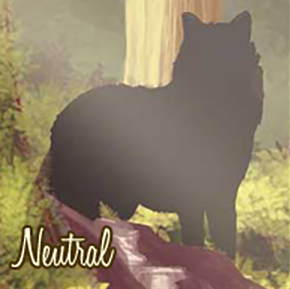
Neutral
|
Northern Cardinal- Size & ShapeThe Northern Cardinal is a fairly large, long-tailed songbird with a short, very thick bill and a prominent crest. Cardinals often sit with a hunched-over posture and with the tail pointed straight down.Color PatternMale cardinals are brilliant red all over, with a reddish bill and black face immediately around the bill. Females are pale brown overall with warm reddish tinges in the wings, tail, and crest. They have the same black face and red-orange bill.BehaviorNorthern Cardinals tend to sit low in shrubs and trees or forage on or near the ground, often in pairs. They are common at bird feeders but may be inconspicuous away from them, at least until you learn their loud, metallic chip note.HabitatLook for Northern Cardinals in inhabited areas such as backyards, parks, woodlots, and shrubby forest edges. Northern Cardinals nest in dense tangles of shrubs and vines
Black-capped chickadee- Size & ShapeThis tiny bird has a short neck and large head, giving it a distinctive, rather spherical body shape. It also has a long, narrow tail and a short bill a bit thicker than a warbler’s but thinner than a finch’s.Color PatternThe cap and bib are black, the cheeks white, the back soft gray, the wing feathers gray edged with white, and the underparts soft buffy on the sides grading to white beneath. The cap extends down just beyond the black eyes, making the small eyes tricky to see.BehaviorBlack-capped Chickadees seldom remain at feeders except to grab a seed to eat elsewhere. They are acrobatic and associate in flocks—the sudden activity when a flock arrives is distinctive. They often fly across roads and open areas one at a time with a bouncy flight.HabitatChickadees may be found in any habitat that has trees or woody shrubs, from forests and woodlots to residential neighborhoods and parks, and sometimes weedy fields and cattail marshes. They frequently nest in birch or alder trees.
Red tailed hawk- Size & ShapeRed-tailed Hawks are large hawks with typical Buteo proportions: very broad, rounded wings and a short, wide tail. Large females seen from a distance might fool you into thinking you’re seeing an eagle. (Until an actual eagle comes along.)Color PatternMost Red-tailed Hawks are rich brown above and pale below, with a streaked belly and, on the wing underside, a dark bar between shoulder and wrist. The tail is usually pale below and cinnamon-red above, though in young birds it’s brown and banded. “Dark-morph” birds are all chocolate-brown with a warm red tail. “Rufous-morph” birds are reddish-brown on the chest with a dark belly.BehaviorYou’ll most likely see Red-tailed Hawks soaring in wide circles high over a field. When flapping, their wingbeats are heavy. In high winds they may face into the wind and hover without flapping, eyes fixed on the ground. They attack in a slow, controlled dive with legs outstretched – much different from a falcon’s stoop.HabitatThe Red-tailed Hawk is a bird of open country. Look for it along fields and perched on telephones poles, fenceposts, or trees standing alone or along edges of fields.
Osprey- Size & ShapeOspreys are very large, distinctively shaped hawks. Despite their size, their bodies are slender, with long, narrow wings and long legs. Ospreys fly with a marked kink in their wings, making an M-shape when seen from below.Color PatternOspreys are brown above and white below, and overall they are whiter than most raptors. From below, the wings are mostly white with a prominent dark patch at the wrists. The head is white with a broad brown stripe through the eye. Juveniles have white spots on the back and buffy shading on the breast. BehaviorOspreys search for fish by flying on steady wingbeats and bowed wings or circling high in the sky over relatively shallow water. They often hover briefly before diving, feet first, to grab a fish. You can often clearly see an Osprey's catch in its talons as the bird carries it back to a nest or perch.HabitatLook for Ospreys around nearly any body of water: saltmarshes, rivers, ponds, reservoirs, estuaries, and even coral reefs. Their conspicuous stick nests are placed in the open on poles, channel markers, and dead trees, often over water
Peregrine Falcon- Size & ShapePeregrine Falcons are the largest falcon over most of the continent, with long, pointed wings and a long tail. Be sure to look at shape as well as size¬ólong primary feathers give the Peregrine a long-winged shape. As with most raptors, males are smaller than females, so Peregrines can overlap with large female Merlins or small male Gyrfalcons. Color PatternAdults are blue-gray above with barred underparts and a dark head with thick sideburns. Juveniles are heavily marked, with vertical streaks instead of horizontal bars on the breast. Despite considerable age-related and geographic variation, an overall steely, barred look remains. BehaviorPeregrine Falcons catch medium-sized birds in the air with swift, spectacular dives, called stoops. In cities they are masterful at catching pigeons. Elsewhere they feed especially on shorebirds and ducks. They often sit on high perches, waiting for the right opportunity to make their aerial assault. HabitatLook for Peregrine Falcons perching or nesting on skyscrapers, water towers, cliffs, power pylons, and other tall structures. If a mudflat full of shorebirds and ducks suddenly erupts from the ground, scan the skies. A Peregrine (or Merlin) is probably in the area. Peregrines can be seen all over North America, but they are more common along coasts.
American Robin- Size & ShapeAmerican Robins are fairly large songbirds with a large, round body, long legs, and fairly long tail. Robins are the largest North American thrushes, and their profile offers a good chance to learn the basic shape of most thrushes. Robins make a good reference point for comparing the size and shape of other birds, too. Color PatternAmerican Robins are gray-brown birds with warm orange underparts and dark heads. In flight, a white patch on the lower belly and under the tail can be conspicuous. Compared with males, females have paler heads that contrast less with the gray back. BehaviorAmerican Robins are industrious and authoritarian birds that bound across lawns or stand erect, beak tilted upward, to survey their environs. When alighting they habitually flick their tails downward several times. In fall and winter they form large flocks and gather in trees to roost or eat berries. HabitatAmerican Robins are common across the continent in gardens, parks, yards, golf courses, fields, pastures, tundra, as well as deciduous woodlands, pine forests, shrublands, and forests regenerating after fires or logging.
|
|
|








